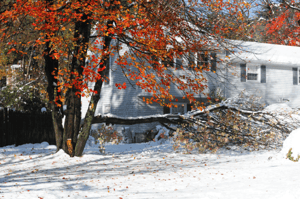Between hurricanes, blizzards, tsunamis and lightning storms, aging infrastructure and car accidents involving utility poles, there’s no shortage of threats that can cause power outages in homes around the world. Given how much we rely on all sorts of electrical devices, it makes sense to think about which devices are really crucial during an outage and the steps you can take to protect them. Call it a “power outage survival kit” or a checklist of emergency items which should also include battery backups.
Power outage preparation tips
The U.S. Department of Homeland Security (DHS) and Canada’s Department of Public Safety and Emergency Preparedness have a number of sound tips on how to prepare for power outages:
Canada’s Department of Public Safety and Emergency Preparedness have a number of sound tips on how to prepare for power outages:
- Make sure you have flashlights and batteries on hand, along with nonperishable food, and water.
- Put a thermometer in your refrigerator and freezers so you know what the temperature is when the power comes back on. If the temperature reaches 40°F or higher, they recommend tossing any food inside.
- Take an inventory of the items you need that rely on electricity and talk to your medical provider about a power outage plan for medical devices powered by electricity and refrigerated medicines.
That’s an important consideration, especially for people who have medical devices that are crucial to their well-being, including home dialysis and oxygen machines, ventilators, and respirators.
Anyone who relies on such life support devices should contact their power and water companies about their needs to ensure they are fully prepared, according to the ADA National Network, which provides information on how to implement the U.S. Americans with Disabilities Act (ADA). It notes many utility companies keep a “priority reconnection service” list and map the locations of power-dependent customers for emergency use. In the UK, vulnerable customers can register for a Priority Services Register. This type of “priority” service is also available in other countries as well, so it is worth looking into this offer if you or a family member need these services.
Your Power Outage Remedy
But, as the ADA National Network notes, even if you are on a priority list, you could still be without power for days following a disaster such as a hurricane. “It is vital that you have power backup options for your equipment,” the site notes.
One option is a generator to power crucial devices and appliances. Generators range from models that are tied to a home’s electrical panel and kick in automatically in the event of an outage to portable models that you fire up manually when needed.
Generators can be expensive, however (not to mention loud), and they may not be a viable option for residents of apartment buildings or condominiums.
The other often overlooked option is a battery backup or uninterruptible power supply (UPS). UPSs come in different sizes with batteries that can power devices for up to several hours, depending on the model and how much power the device consumes. (For medical devices, that’s where the conversation with a medical professional is important.)
In addition to medical equipment, UPSs can supply power to devices such as routers and modems, to maintain Internet connectivity – which can be important for getting outage updates. Maintaining this Certainty in a Connected World with the help of a UPS keeps you connected to critical information, particularly in an emergency. A UPS can also be used to power essential equipment, including sump pumps to prevent flooded basements. Some UPSs also have USB ports, to keep phones and tablets charged.
Surge protectors: for when the power comes back
During a power outage, the DHS recommends turning off or disconnecting appliances and other electronics. The reason is that when the power returns, it can result in power surges or spikes that can cause damage.
While that is sound advice, it’s also a good practice to use surge protectors for any sensitive electronic equipment, such as computers, televisions and home entertainment systems (a topic covered in this previous post on surge protection). A surge protector is a power strip that protects the devices plugged into it from short bursts of power – surges – that are higher in voltage than the devices can handle. If you routinely use surge protectors for your most valuable or sensitive electronics, you won’t have to worry about problems when the power comes back on.
No matter where you live around the globe, it’s likely you will suffer a power outage at some point. To make sure you’re prepared, explore our guide on selecting a battery backup system or visit our home solutions page. You’ll find information on UPSs, surge protectors and other home power protection solutions.


.png?width=58&height=58&name=X_logo_2023_(white).png)
